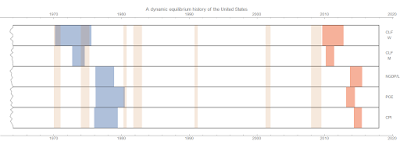Forecast performance of a quantity theory of labor
One of the dynamic information equilibrium model forecasts I've been tracking on the order of a year now to measure its performance is what I call the "N/L" or "NGDP/L" model [1] (specifically FRED GDP, i.e. nominal GDP, divided by FRED PAYEMS, i.e. total nonfarm payrolls). Revised GDP data came out today, so I thought it'd be a good time to check back in with the model [2]:


One way to think about this is as a measure of nominal productivity. We are coming out of the aftermath of the shock to the labor force following the great recession, so we can see a gradual increase back towards the long-run equilibrium.
If we use this dynamic equilibrium model instead of NGDP alone as the shocks, we can see in a history "seismograph" that this measure basically coincides with the inflation measures.

There's a good reason for this: this is effectively a model of Okun's law (as described here) if we identify the "abstract price" with the price level P:
$$
P \equiv \frac{dNGDP}{dL} = k \; \frac{NGDP}{L}
$$
which can be rearranged
$$
\begin{align}
L & = k \; \frac{NGDP}{P} \equiv RGDP\\
\frac{d}{dt} \log L & = \frac{d}{dt} \log RGDP
\end{align}
$$
to show changes in employment (and therefore unemployment) are directly related to changes in real GDP.
...
Footnotes
[1] Also, the "quantity theory of labor" per the title because the model implies log NGDP ~ k log L.
[2] Here is the complete model:




